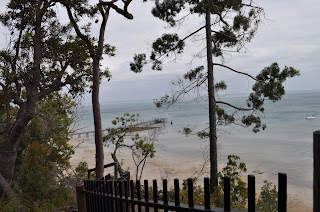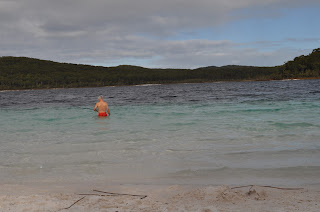This time it was Lady Elliot Island (LEI) which is 85 km. off the coast of Bundaberg. John had planned it all, another "not to be missed" place which we could access very easily. After the worst thunderstorm we've experienced in the early morning before our flight, we weren't sure we'd even have a flight. The power went out, the wind must have been blowing at 40-50 mph, and we were pretty sure 1-2 inches of rain had fallen. Our flight was at 8:40am and by the time we got up the weather had improved and we were on our way.
This is a charter flight which I could really get used to, no ID's, no XRay, and just walking onto to flight. We were in the air only about 25 minutes before the Island was there.
 |
| Bundaberg by air |
 |
| The 2 tan plots are the Bundaberg Tennis Club where we play. |
We arrived on the Island by 9:10am and we were ready to get going snorkeling!

LEI is a coral key, and the southern most island in the Great Barrier Reef.
http://www.ladyelliot.com.au/files/pdf/manta-rays-fact-sheet.pdf
We got to our room and changed into swimsuits so we could get into the water and start snorkeling. The weather wasn't great, cloudy and a bit cool(73 or so), but we thought the next day might be even cooler so let's get on with it! We headed to the far side of the island where the low tide doesn't make a huge difference. We saw a couple of turtles, Green Turtles which look brown, and lots of beautiful fish and coral. Because it was cloudy, the water clarity wasn't great, and I got cold so we finished our swim in about 45 minutes. We don't have an under water camera so no pictures to show.
Part of the mission of LEI is that it's eco-sensitive. In short it means you don't get fresh linens or towels daily, and you can't buy bottled water. That's not entirely true. They also have educational walks and lectures on the flora, fauna, and fish. We sat in on the Manta Ray talk which was a power point about the Rays here on the Queensland coast. Elana was the naturalist who spoke and she gave an interesting talk on them. We headed from there to a Rim Walk, which is a walk during low tide on the coral reef which is visible when the water is low. Elana lead us around giving us information about the sea life which was around as we walked.
As you can see, the weather wasn't sunny and warm!
We were a little disappointed with the knowledge base from the naturalist, she only identified about 10 different animals, which compared to other walks we've done, was pretty lame. We saw these starfish,
 |
| Blue Linkia Starfish |
and loads of sea cucumbers. Some Red Eyed Crabs, a Moray Eel,
There were lots of these little crabby's around
We walked for over an hour on the broken coral skeletons that make up the rim, which the shallow edge of the shore where the waves crest. As we walked the naturalist lectured us on climate change and it's effect on the GBR. One effect (she said) was on the turtle population. The temperature of the sand where the eggs are laid determine the sex of the turtle hatchling, and if it's warmer you get more females. John remarked that would be a good thing, more females laying eggs and turtles being hatched. She didn't respond to that observation. There's no doubt that the Reef has been effected by the increase in tourism, sunscreens being one of the biggest chemicals its exposed to. It's a double edged sword here in Queensland in that you need the sunscreen to protect you from the damaging rays of the sun, especially through the shallow water when you snorkel. BUT, the coral doesn't like it so they ask you to apply it well before you get in so it's absorbed and not easily rinsed off. I'm not sure it doesn't rinse off whenever you apply it, but it's become a habit to get the lotion on first thing anyway, so if it helps the Reef, I'm all in.
We returned from the walk and get ready for our dinner, which was served buffet style in the dining area. Unfortunately, dinner was a miss, the salad bar was tasty but the main course was beef ribs and they were so tough that you couldn't eat them. Scout and Bear would have loved those leftovers!
We were pretty tired from all the activities so we headed to our room, which was very basic, no TV or radio, or IPod dock. Luckily we brought books to read.
I have yet to mention the biggest event on LEI, which was the migration of literally tens of thousands of birds. We are talking Alfred Hitchcock stuff here. The majority of them were Black and Common Noddies, black-naped, bridled, crested, roseate and sooty terns; pied and sooty oystercatchers; wedge-tailed shearwaters, silver gulls and the threatened red-tailed tropic bird. If I were a serious bird watcher that would have been the highlight but it was too small an island for so many birdies! When the wind died down it stunk like, well, bird poop. And the squawking was non-stop, day and night. I guess there were some night only migraters who settled in looking for "that someone special" and they made noise all night. Truly it was creepy as the pictures show.
 |
| Common Noddy |
 |
| I'm talking about you |
 |
| Thousands of nests |
Really spooky
Can you see what I mean? I think these were all that Common Noddy, too darn many of them!
 |
| This is the rare Red Tailed Tropic Bird We did get awakened many times during the night as something was nested under our building. The buildings are all raised off the ground for drainage when the cyclones blow in. That leaves lots of real estate for the birds to build nests that are protected from the elements. There were as many bird enthusiasts as snorkelers on the Island, and if anyone ever saw "Mr Hobbs takes a Vacation" with Jimmy Stewart, the birdwatchers we saw were dead ringers for the character in the movie. If you've never seen this movie it's worth finding it and watching. So you might have figured out that the birds in the country are FREAKING ME OUT! Ever since the Magpie swooping trauma I have been PTSD with any loud and aggressive bird. Enough, now you all (all 5 of you) know. For the curious out there, we did see Manta Rays! They are incredibly lovely to see flying through the water with their entourage of cleaner fish trailing behind. They hung out by the reef rim where the bottom fell off quite abruptly, the naturalist said to look there and that's where we found them. Since the Island is known for Manta's it would have been a deal if we hadn't seen them. We also saw Green Turtles and maybe a Hawkhead Turtle. John saw a different Ray, a Cowtail Ray, in the lagoon where he also swam with a couple of Green Turtles. http://www.ladyelliot.com.au/files/pdf/sharks-and-rays-fact-sheet.pdf All in all it was a fabulous couple of days, and except for a warning light going on during the flight home and our 10 year old pilot (Ok, he was a bit older than that but not much) flipping through the instruction manual to see what the red flashing light meant, we had a nice flight back to Bundaberg.
OK, he was even shaving. The light was a low fuel light, and the tank pumper met us on the air strip after we landed in Bundaberg. We were very glad to have landed without any issue, but you never want to see a flashing red light.
Here is a couple of You Tube videos of Manta Rays and Turtles swimming, enjoy!
|

































































